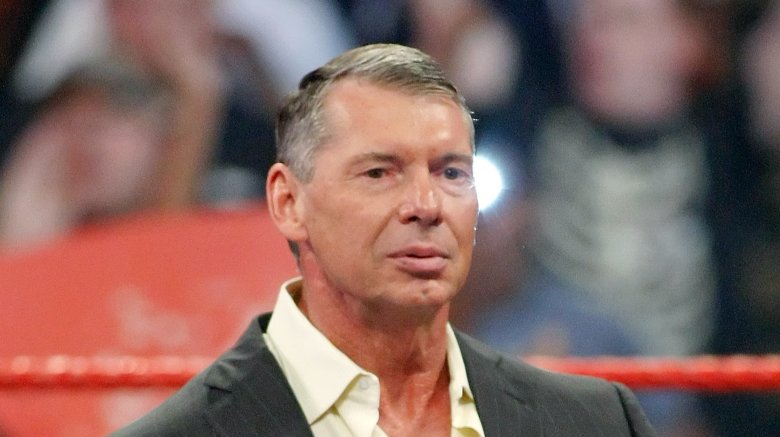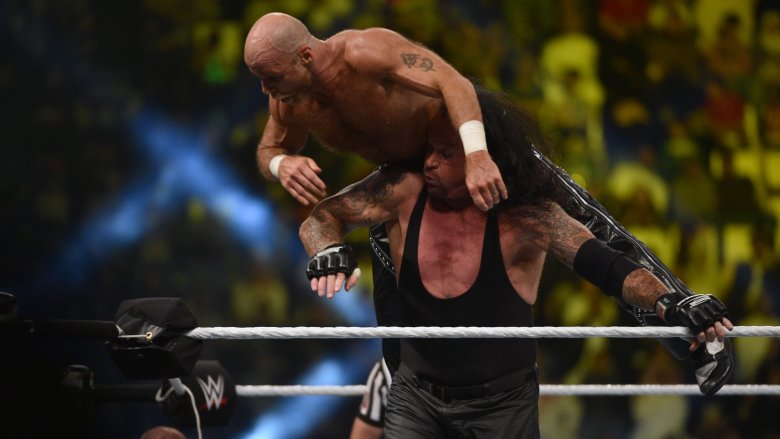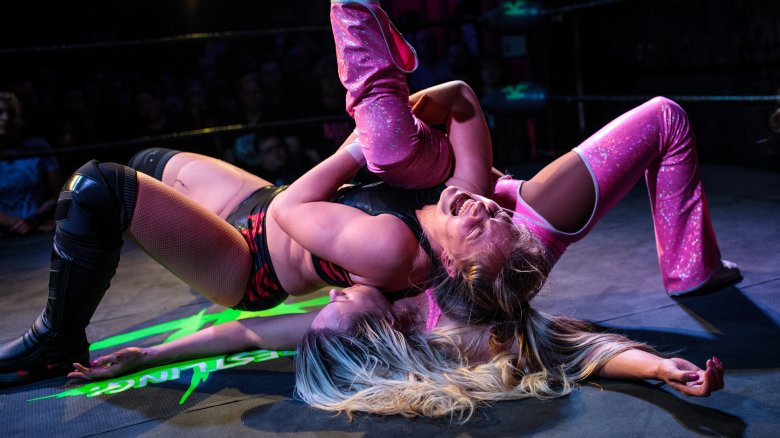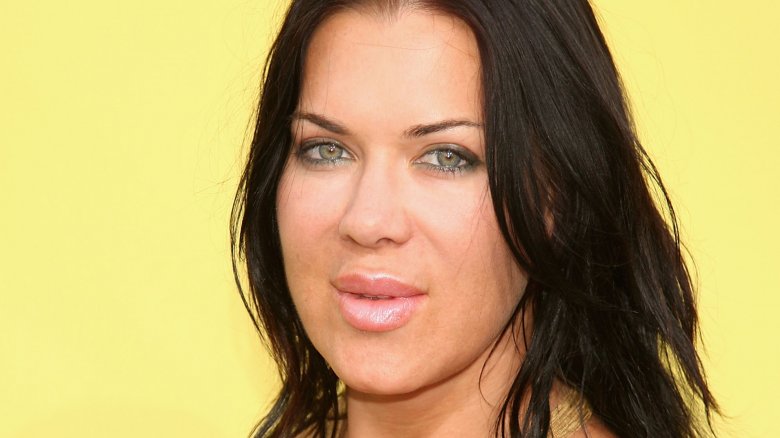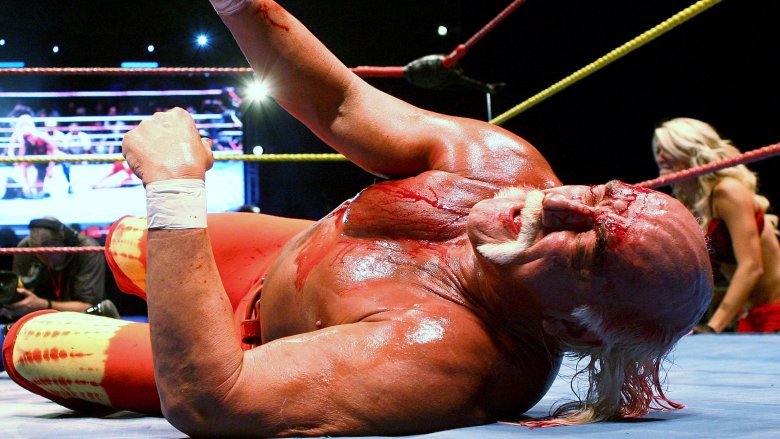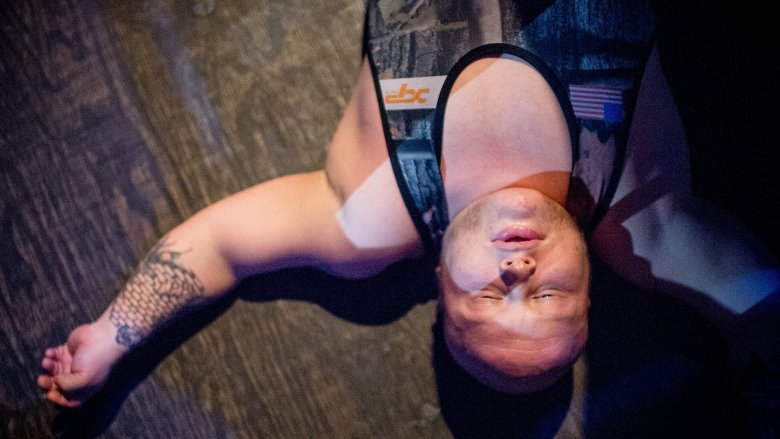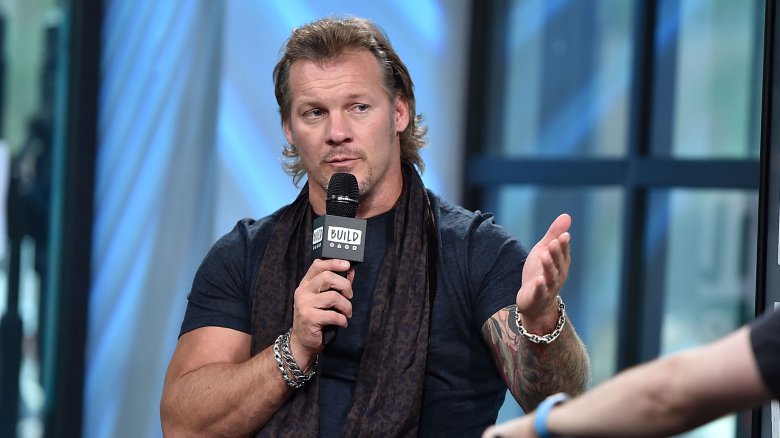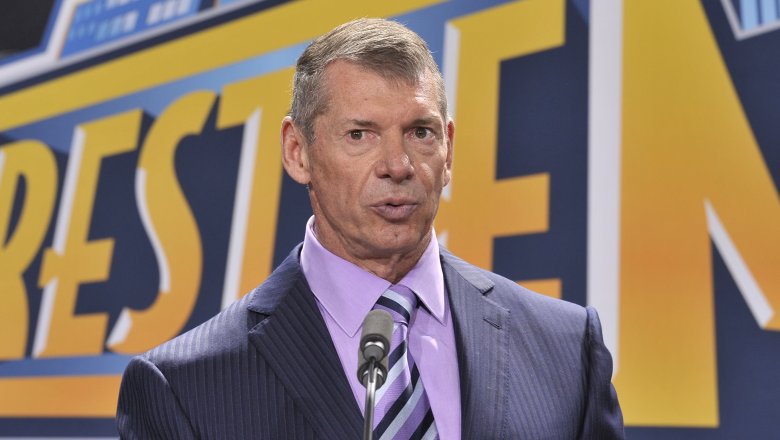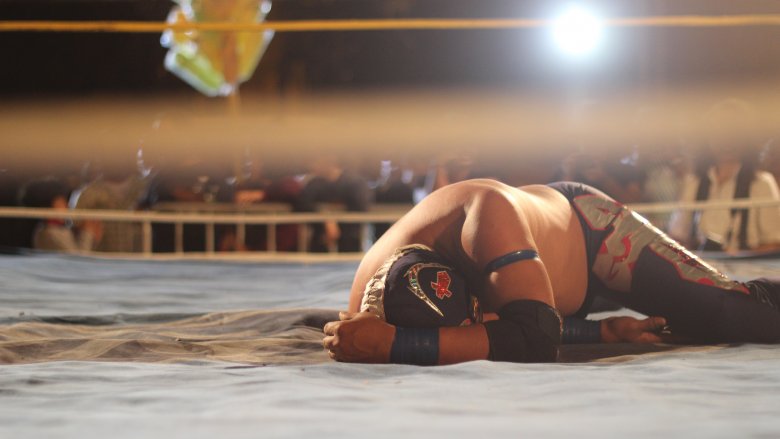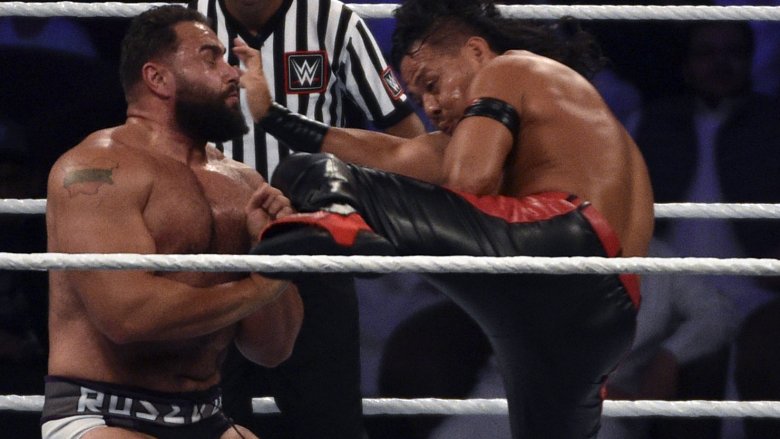The Tragic Truth About The Life Of A Professional Wrestler
Professional wrestling is one of the weirder parts of the cultural landscape. One part theatrics, one part soap opera, with a slice of athletic ability, professional wrestling events are one of the few places where families can go to watch grown adults strut around in elaborate costumes and hit each other with chairs. Crazy stuff.
If you're one of the millions of kids who cheered at the defeat of some dastardly foe in the ring and have considered becoming a professional wrestler yourself, be warned: It's not easy. Whether you're being body-slammed in pay-per-view WWE championships or just participating in small-scale charity matches at the local gym, mastering the performance aspect of professional wrestling is quite a skill, and the physical toll it takes on your body is no joke. While professional wrestling certainly isn't "real," it's not fair to discount the tears, sweat, blood — and broken limbs — that real wrestlers encounter in the ring, not to mention the struggles that happen behind the scenes.
Workplace hazards
The truth is, professional wrestling has a lot more in common with a Shakespearean play (even down to the lewd insults) than with the original sport it was named after. Wrestlers are actors, putting on heroic or villainous performances to entertain a crowd. However, the popular statement that "wrestling is fake" doesn't do justice to the all-too-real damage that wrestlers do to their bodies in the name of art. Sure, any good actor can fake a heel turn. But you try taking a metal chair to the head and see how you feel the next day.
Speaking of chairs to the head, well ... back in 2016, the Chicago Tribune reported that dozens of WWE wrestlers were suing the organization over brain injuries, caused by wrestling matches, that had resulted in long-term neurological damage. That's bad enough, but the primary accusation was that the WWE had intentionally covered up these injuries to avoid paying for proper medical treatments. Scary stuff? Yeah, but there's a bigger issue: Wrestling culture itself encourages terrible injuries since the audience goes so crazy over ridiculous athletic feats. An orthopedic surgeon writing for the Post & Courier admitted that some of the moves he sees wrestlers perform cause him to literally hold his breath, and as an increasing number of performers attempt these high-risk moves, the deadly consequences have included broken backs, snapped necks, torn quads, and ears getting ripped off, according to Complex. Uh, ouch?
No rehearsals
Professional wrestling is scripted. Duh. The winners are planned ahead. Another duh. However, what you might not realize is that the matches themselves are barely written down at all, according to the Week, as the actual script summarizes the entire blow-by-blow with only two terms: "Match" (for the fight) and "Finish" (for the concluding move). That means it's up to the wrestlers themselves to figure out how many times they're going to punch, grapple, and body-slam each other before the whole thing reaches its planned conclusion.
You think those guys are going to memorize, rehearse, and replay an entire 30-minute sequence of jabs with no improvisation? Yeah, right. But while many wrestlers do discuss a rough sequence of events with each other, even those plans can change on the fly. According to one former independent wrestler, those referees who appear to be barking orders all the time are actually amateur directors who continually give directions to the wrestlers based on crowd reactions, backstage directions through their earpiece, and so on. Now, improv is one thing when you and a friend are playing around on a regular stage and making funny voices, but it's a lot more dangerous when you're in front of a massive audience and someone is stomping on your spine. Needless to say, if your opponent decides to try some freaky new move without warning and you're not prepared, you might spend the night in the emergency room. Yikes!
Professional wrestlers often die young, and it's a real problem
André the Giant. Chyna. Randy Savage. Chris Benoit. When you list the biggest names in wrestling history, a shockingly high percentage of them died at an early age. Sure, people die for all kinds of reasons, but as the BBC points out, the statistics show that wrestlers die younger and more often than other professional athletes. When the University of Michigan studied 557 former wrestlers, they found that 62 of them had died before the year 2011. What's more, 49 of the wrestlers were younger than 50, and 24 of them weren't even 40 yet. Meanwhile, American football players engage in an equally demanding profession, also have a high rate of head injuries, and yet die young in far smaller numbers.
There are some common trends. For example, cardiovascular disease seems to be the biggest killer of wrestlers, and it isn't helped by either the aggressive injuries or the rock star lifestyle that the wrestling circuit promotes. Steroids, recreational drugs, and alcohol abuse has often been rampant. Another problem? No vacation. While football players run for a season, then take the rest of the year off to sip margaritas, wrestling careers don't offer much in the way of free time. Some wrestlers have to be in the ring five or six nights a week, every week, while undergoing feverish travel routines that almost certainly contribute to sleep loss. It's a rough life, and if you're not careful, the consequences will catch up to you.
The training is intense
So, you know the risks. You understand the challenges. Despite it all, you still dream of being a professional wrestler ... and hey, good for you. Follow your dreams! Before you go waltzing into some random ring, though, you're going to have to go to wrestling school, where you'll pay decent money to have someone kick the crap out of you.
There are a number of different programs that will teach you how to work the ring, make pained expressions, and play to the crowd. Business Insider reports that these schools are sometimes taught by major WWE superstars, like Bull James, and can cost around $1,800 for an entire year's sessions (though many schools cost a few grand more). According to Medium, though, not all wrestling schools are created equal. There are good teachers and bad teachers, so if you're in to win it, make sure you pick the right program. How rough do these classes get? Well, ask Hulk Hogan. According to Complex, the young Hogan's first educational session came free with a broken leg, courtesy of trainer Hiro Matsuda. Despite this rather alarming incident, Hogan came back a few months later, impressing everybody with his dedication ... and, evidently, his lack of an attorney.
The upfront cost is huge, and the starting pay ain't great
Even after you've paid for school and earned your bruises, the freshman wrestler doesn't usually just step onto the stage of a WWE match and leave with a paycheck. As Make Change points out, wrestling isn't a 9-to-5 job with benefits, but rather, a freelance gig that needs to be balanced with a day job (at first). The first shows you book won't pay much, and you'll probably be racking up debt with the constant travel, gas bills, hotel charges, costume repairs, and whatever medical needs arise after your daily dose of elbow jabs and knees to the chest. If you love it, of course, you'll sweat it out ... but yeah, you better love it.
Now, once you've factored in the mental, physical, and financial costs? Add in time, according to Studenomics. First off, you've got to spend hours at the gym bulking up. Then you'll need to spend more hours self-promoting. Of course, there's no assurance that all this hard work is ever going to get you past the low-paying independent circuit, which Cracked says might earn you $50 on a good night, depending on your location and popularity.
Obviously, that's not anywhere close to the earnings made by the WWE's John Cena, who pulls down millions between his wrestling and other projects. So sure, if you make it to the big leagues, you'll earn a ton, but you'll have to work hard (with no guarantees) to get there.
Buy your own health insurance, bucko
Most wrestlers are considered independent contractors rather than employees. To clarify, for all you full-time folks, that means they've got the same benefits as your Uber driver, or the photographer you hired for your wedding — squat. There's a lot of tax jargon involved, but according to SB Nation, even companies like the mighty WWE don't provide health insurance to their wrestlers. Kind of messed up, no? Seriously, it's one thing if a company doesn't want to pay insurance bills for a traveling freelance keyboard inspector, but you'd hope there would be some coverage for a job that entails daily headbutting. To make matters even fishier, the WWE contract mandates that wrestlers must have their own insurance, paid for and maintained at contractor expense. That's rubbing salt in the wound.
So what happens if somebody gets catastrophically hurt? Well, Forbes points out that the contract includes a clause waiving the wrestler's right to sue in such unfortunate situations, even if the injury is the promoter's fault. Eesh. For a sense of how problematic this clause is, look at Owen Hart, who fell to his death in 1999 because of a harness malfunction. Hart's family did sue the WWE and won an $18 million settlement, but still.
The schedule is brutal
Hate traveling? Wrestling might not be your jam, then, because you're going to be on the road (or in the air) so often that the idea of a steady "routine" will seem as fantastical as anything in Game of Thrones.
It's one thing if you're a new wrestler just hitching a ride to any available shows you can find on Craigslist, but even big league WWE wrestlers have to constantly hop on planes, do midnight drives, and see new cities like there's no tomorrow. Just ask Neville, according to Wrestling Inc., who wrestles his way through early morning flights without skipping a beat. Then there's Chris Jericho, who shared with his Instagram followers how over the course of nine days, he was scheduled to fly between Tampa, Detroit, Kansas City, London, Hong Kong, Manila, Shanghai, Baltimore ... and then back to Tampa. Doesn't sound like there's any time for sightseeing in that whirlwind.
Drug culture
Wrestlers are supposed to be ripped. That's just the way it is. Sure, a skinny wrestler could try to make up for their lanky physique with elaborate costumes and theatrics, but face it, people expect you to look like a Rob Liefeld drawing. That means lots of long, strenuous hours in the gym, week after week, combined with ruthless dieting until your tree trunk arms are complemented by an equally insane twelve-pack stomach.
Or you could take the "easy" way, ignore the consequences, and simply grab some steroids or human growth hormone (HGH). Not surprisingly, Ashland Tidings reports that steroid and HGH abuse has often been rampant in the wrestling community, with dire health consequences.
Steroids aren't the only drugs that are prevalent among wrestlers, though. Bruises and broken bones often lead to painkillers, which can be terrifyingly addictive. Add in cocaine and muscle relaxants, and you've got an increasingly deadly cocktail that nobody's body is prepared for. While big organizations like the WWE do have drug policies, according to Forbes, the lax enforcement of these has often come under fire. Part of the problem is that since wrestling matches are scripted, those HGH-jacked physiques don't impact the fights themselves, so drug policy specifics run into some gray areas.
A history of sexism
To be blunt, the WWE has never been known for possessing much social awareness or sensitivity, but the organization has a particularly poor history when it comes to the treatment of women. Objectification, sexist taunts, body shaming, and misogynistic stereotypes have been baked into the formula for a long time, and while recent moves like marketing products at female fans are a step forward, the organization still has a long way to go. As Cultured Vultures explains, the sort of stories and characters available to female wrestlers are still dramatically limited compared to the opportunities afforded to men, which has been attributed both to a lack of female presence behind the camera — e.g., no women writers — and the generally misogynistic attitude held by WWE owner Vince McMahon, who once forced a female wrestler to strip on stage as a punishment. Yes, he was playing the "villain" in that scenario, but the sexist undercurrent isn't hard to spot.
Another clear indicator that sexism in the WWE is still a big problem? The pay gap. If you're a big name female wrestler, the Daily Beast reports that your male coworkers will be making at least 36 times more money than you on average. Hmm, definitely not okay. So yeah, while the WWE has made a lot of surface overtures about empowering women, the results (still) show otherwise.
You're signing away some big rights
The fact that WWE wrestlers are classified as independent contractors rather than true employees is already bad, but on top of that the organization will do everything it can to make you sign your life away (sometimes literally). A contract analysis by Forbes shows that writing your name on the dotted line can also mean giving away some major rights that you'd probably rather hold onto.
Like what? Well, even though you're the one who spent years creating and inhabiting the character you play in the ring, this contract gives that character's rights away to the WWE, who will make sure to market it, license it, and potentially steer it into storylines you'd rather avoid. What, you didn't plan on being a heel or saying something particularly cringey? Too bad. Meanwhile, the contract also allows the WWE to book you for events. That sounds great until you're flying from London to Las Vegas to Singapore every few days, but honestly, that's the nature of the business. Far more concerning is the clause that clears the WWE of all liability if an elaborate stunt (whether it's arranged by you, or them) leaves you traumatized, paralyzed, dead, or so on. Apparently, this clause is written in all-caps on the contracts of Triple H and Stephanie McMahon. You know, for emphasis.
Racism in (and out of) the ring
There's no denying that the WWE has a long, uncomfortable history of exploiting racist and/or xenophobic stereotypes as a way to sell tickets. For example, the Guardian points to many villain characters, such as the so-called Iron Sheik, who traded on anti-Muslim stereotypes to get the audience rooting for an "all-American" blond, white, male hero. Just as damaging has been the treatment of black wrestlers, who have been portrayed as cannibalistic headhunters from Uganda, voodoo priests, and pimps.
Though smaller wrestling organizations have tried to shift the industry away from such vulgar stereotypes, the WWE still has a long way to go. In 2017, the Washington Post reported that one wrestler went on a scripted tirade filled with racist stereotypes about Asians. Now, this sort of blatant prejudice is obviously not okay, but as the Atlantic points out, the racism in WWE storylines is usually more subtle (though equally damaging). For example, most of the WWE's black wrestlers are usually positioned as "jobbers," meaning their job is to lose matches in order to bolster the profile of a villainous opponent. It almost invariably ends up being a white man who finally wins against the heel, a problematic narrative that quietly asserts a notion of white supremacy without outright stating it. The WWE often pretends that these racial stereotypes are employed for satirical purposes, but in reality, the organization has a serious race problem and needs to do more about it.
